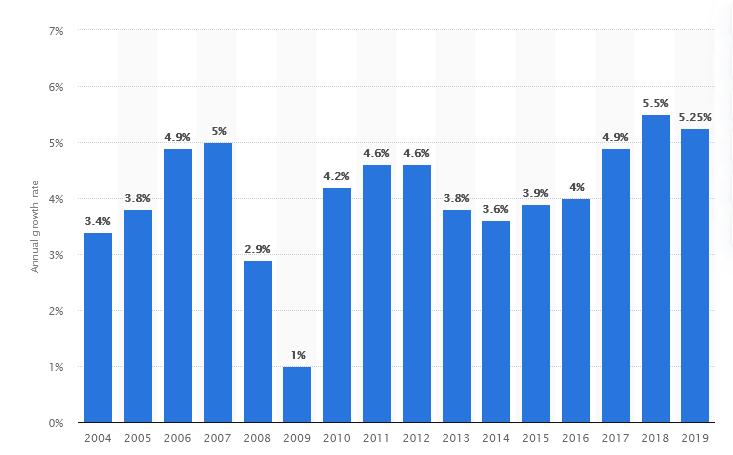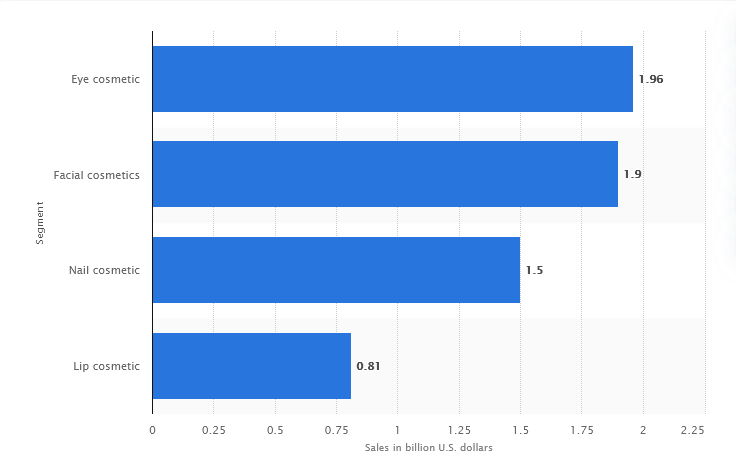The industry of beauty and cosmetics has been on a steady increase over recent years. The market has seen a surge in the number of companies and products, contributing to the highly competitive environment within the sphere. New brands appear regularly, and the offered range of existing ones continues to expand, attempting to follow the changeable trends. Sephora is a renowned leader in the beauty industry, showing outstanding results in a highly competitive field. The purpose of this essay is to examine the case of Sephora, outlining its history, strategy, and performance.
The beauty industry has been experiencing a rapid development instigated by progress and changeable trends. There is a high demand for modern, fashionable, and safe cosmetics, which has led to considerable growth of the sector worldwide. As presented in Figure 1, the global cosmetics market has seen an increase of four percent on average most years within the period between 2004 and 2019. The activity related to cosmetics retail in the United States has received a North American Industry Classification System code of 446120 (NAICS Code: 446120, n.d.) As statistics suggest, eye products form the most profitable American market segment, followed by facial cosmetics (Figure 2). Overall, data shows that the development of the discussed industry has been stable, which inevitably attracts new players making the sphere highly competitive.


Historical findings suggest that humanity has been familiar with cosmetics for a long time, as the ability to hide some imperfections while highlighting the advantages has always been appealing to people. Ancient civilizations, such as Egypt and Rome, produced a range of products for skin and hair, which were mostly used by the aristocracy (History of cosmetics, n.d.) A similar tendency has persisted throughout the Middle Ages and Renaissance, but the image of cosmetics became completely redefined in the present.
By the 21st century, cosmetics became available to a wide audience, allowing people to treat aesthetic issues effectively. The expanding scale of production and consumption has transformed cosmetics into a veritable industry with billions of dollars of turnover. In addition, the global pursuit of sustainability, becoming a dominant corporate paradigm in developed countries, has encompassed the beauty industry, as well (Bom et al., 2019). Overall, the 21st-century market is characterized by inclusiveness, providing suitable products for various skin types and tones.
Within this competitive and changeable market, strong companies with a refined corporate model achieve success. Sephora ranks among the leading organizations of the beauty industry, establishing the entire world’s trends (NAICS Code: 446120, n.d.) The company was originally based in France, from where it began its global expansion, becoming one of the best offers in the U.S. market in 1998 (Sephora, n.d.) Over the two following decades, Sephora opened over 600 stores across the country, as well as five distribution centers, which form parts of its global infrastructure (Sephora, n.d.) The company’s business model aims at establishing and maintaining a global dominance in the mid-range cosmetics market through rapid expansion. In addition, Sephora nurtures a positive image of the organization, as its purpose statement revolves around the concepts of inclusiveness, inspiration, and empowerment (About us, n.d.) The company wants to make quality beauty products widely available to the public, combining business ethics and profitability of the enterprise.
The aim of the massive global presence is expected to ensure Sephora’s domination in the market and yield considerable financial results. Sephora is incorporated into the LVMH Group, which enables better financial stability through the support of a luxurious conglomerate. According to the LVMH’s (2020) report, Sephora demonstrates admirable resilience in the context of Covid -19-related challenges.
The company’s position remained stable, as the number of its stores continued to increase from 1910 to 1970 in one year (LVMH, 2020). The Group publishes consolidated financial statements, which reflect an annual growth despite the challenges of the pandemic (Figure 3). In turn, experts expect Sephora’s U.S. branch alone to achieve the level of $1.4 billion in revenues in 2021 (Sephora Usa, Inc, 2021). Such a level of resilience and stability contributed to the overall success of the company.

Sephora’s offers comprise a wide variety of high-quality cosmetic products. The company’s website provides substantial information regarding its leading solutions in terms of skincare, makeup, and hair products (Sephora, 2021). In addition to these categories, Sephora offers fragrances, which reflects its cooperation with other elements of the LVMH Group. However, perfumes and accessories merely complement the powerful core of fine cosmetics, which have determined the company’s image as the leader of the industry.
The products are not cheap, but they are still available to the general public willing to pay for quality. Sephora has been emphasizing the issue of diversity and representation, and young women of color between the ages of 24 and 35 may be viewed as the most recent addition to the target audience. However, Sephora remains available to all open-minded people who value its expertise in cosmetics.
In conclusion, the origins of the beauty industry stem from ancient civilizations, but its nature has been redefined by history. Today, cosmetic products are available to the general audience, helping people achieve the desired aesthetic effect. Starting from the end of the 20th century, Sephora became one of the leaders of the industry, setting its trends worldwide. The company aggressively expands, aiming at a global presence. The quality of its products is complemented by the focus on business ethics and modern values, which creates a positive image of Sephora and contributes to its resounding success.
References
Bom, S., Jorge, J., Ribeiro, H. M., & Marto, J. (2014). A step forward on sustainability in the cosmetics industry: A review. Journal of Cleaner Production, 225, 270–290. Web.
History of cosmetics. (n.d.) The Connecting World. Web.
LVMH. (2020). Translation of the French interim financial report. Web.
NAICS Code: 446120. (n.d.) NAICS. Web.
Sabanoglu, T. (2020). Cosmetic sales in the United States in 2020, by segment. Statista. Web.
Sephora Usa, Inc. (2021). Dun & Bradstreet. Web.
Sephora. (2021). Web.
Sephora. (n.d.). About us. Web.
Statista Research Department. (2020). Annual growth of the global cosmetics market from 2004 to 2019. Statista. Web.
